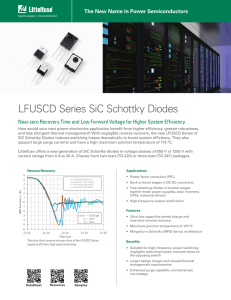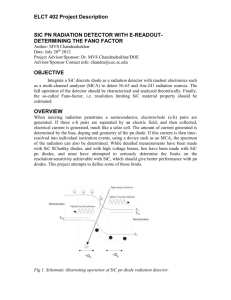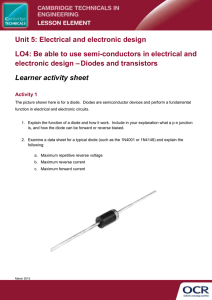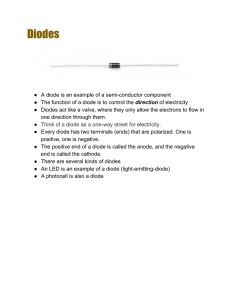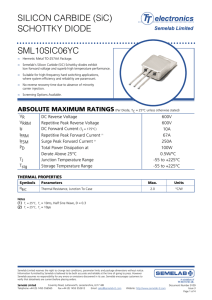Macromodeling with Spice of SiC Schottky Diode
advertisement
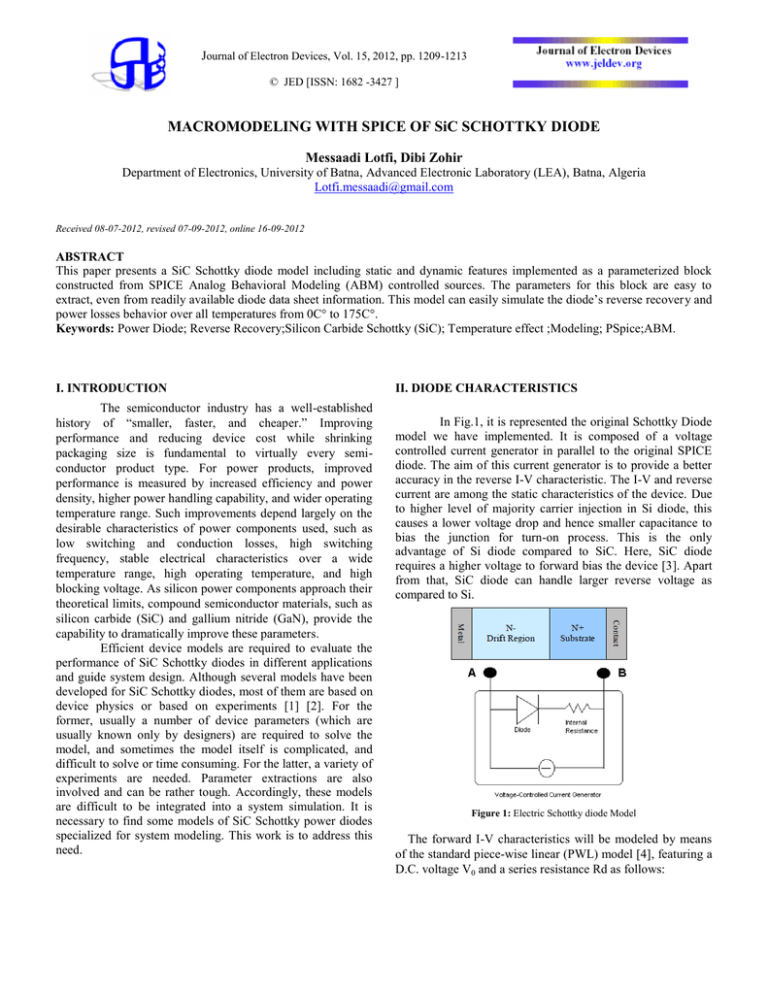
Journal of Electron Devices, Vol. 15, 2012, pp. 1209-1213
© JED [ISSN: 1682 -3427 ]
MACROMODELING WITH SPICE OF SiC SCHOTTKY DIODE
Messaadi Lotfi, Dibi Zohir
Department of Electronics, University of Batna, Advanced Electronic Laboratory (LEA), Batna, Algeria
Lotfi.messaadi@gmail.com
Received 08-07-2012, revised 07-09-2012, online 16-09-2012
ABSTRACT
This paper presents a SiC Schottky diode model including static and dynamic features implemented as a parameterized block
constructed from SPICE Analog Behavioral Modeling (ABM) controlled sources. The parameters for this block are easy to
extract, even from readily available diode data sheet information. This model can easily simulate the diode’s reverse recovery and
power losses behavior over all temperatures from 0C° to 175C°.
Keywords: Power Diode; Reverse Recovery;Silicon Carbide Schottky (SiC); Temperature effect ;Modeling; PSpice;ABM.
I. INTRODUCTION
The semiconductor industry has a well-established
history of “smaller, faster, and cheaper.” Improving
performance and reducing device cost while shrinking
packaging size is fundamental to virtually every semiconductor product type. For power products, improved
performance is measured by increased efficiency and power
density, higher power handling capability, and wider operating
temperature range. Such improvements depend largely on the
desirable characteristics of power components used, such as
low switching and conduction losses, high switching
frequency, stable electrical characteristics over a wide
temperature range, high operating temperature, and high
blocking voltage. As silicon power components approach their
theoretical limits, compound semiconductor materials, such as
silicon carbide (SiC) and gallium nitride (GaN), provide the
capability to dramatically improve these parameters.
Efficient device models are required to evaluate the
performance of SiC Schottky diodes in different applications
and guide system design. Although several models have been
developed for SiC Schottky diodes, most of them are based on
device physics or based on experiments [1] [2]. For the
former, usually a number of device parameters (which are
usually known only by designers) are required to solve the
model, and sometimes the model itself is complicated, and
difficult to solve or time consuming. For the latter, a variety of
experiments are needed. Parameter extractions are also
involved and can be rather tough. Accordingly, these models
are difficult to be integrated into a system simulation. It is
necessary to find some models of SiC Schottky power diodes
specialized for system modeling. This work is to address this
need.
II. DIODE CHARACTERISTICS
In Fig.1, it is represented the original Schottky Diode
model we have implemented. It is composed of a voltage
controlled current generator in parallel to the original SPICE
diode. The aim of this current generator is to provide a better
accuracy in the reverse I-V characteristic. The I-V and reverse
current are among the static characteristics of the device. Due
to higher level of majority carrier injection in Si diode, this
causes a lower voltage drop and hence smaller capacitance to
bias the junction for turn-on process. This is the only
advantage of Si diode compared to SiC. Here, SiC diode
requires a higher voltage to forward bias the device [3]. Apart
from that, SiC diode can handle larger reverse voltage as
compared to Si.
Figure 1: Electric Schottky diode Model
The forward I-V characteristics will be modeled by means
of the standard piece-wise linear (PWL) model [4], featuring a
D.C. voltage V0 and a series resistance Rd as follows:
Messaadi Lotfi and Dibi Zohir, Journal of Electron Devices, 15, 1209-1213 (2012)
VD=V0+RD ID
(1)
Temperature dependence for V0 and Rd is introduced at this
point as:
V0=V00+αV (T-T0)
(2)
Rd=Rd0+αR (T-T0)
(3)
Reverse recovery is one of the properties in a diode. It can
be a factor in determining the efficiency of the applications.
When a diode has been conducting in a forward bias long
enough for it to establish steady state, there will be charges
due to the presence of minority charge carriers. This charge
must be removed to block in reverse direction [6].
Where V0 temperature dependence is assumed linear, which
is a good fit in practice, and series resistance is fitted by a
power law. If we want a simpler linear model we can make
n =1. However, a better fit is generally achieved if n has a
value between 2 and 3. For practical purposes, the value 2 can
be forced with sufficient approximation. T 0 is the reference
(ambient) temperature.Substituting (2) and (3) into (1) we get
for the diode forward drop, including temperature variation:
Vd=V00+αV(T-T0) +Rd0.ID+αR. (T-T0) n
(4)
This constitutes the model equation. Note that the way
equations (2), (3) and (4) are stated, αV and αR have
dimensions of V /ºC and Ω / (ºC) n. This is consistent with the
way parameters are extracted from data sheet or
measurements.
III. DYNAMIC CHARACTERISTIC
The characteristic that changes with time is inherited
in both devices. Si and SiC diodes are compared in terms of
the reverse recovery time, reverse recovery current and
corresponding switching losses. The comparisons in dynamic
characteristics between two devices are tabulated in Table 1.
The SiC and Si diodes used are of part number SDP04S60 and
SB30-03F respectively [5].
Table 1: Comparison of Dynamic Characteristics
Characteristics
Reverse
Recovery Time
Reverse
Recovery Current
Switching
Losses
SiC Schottky
(SDP 04S60)
Unchanged
with
temperature
variation
Negligible
Low
Si Schottky
(SB30-03F)
Increases as
temperature
increases
Figure 2: Reverse Recovery Current Characteristic
The characteristic of reverse recovery current experienced
by a diode is represented in Figure 2 above. trr represents the
reverse recovery time, Irr is the peak reverse current whilst ta is
the transition time due to charge stored in depletion region of
the p-n junction. tb is the time for the current to relax to zero.
The peak reverse recovery current depends on the falling rate
of change in current during turn-off. In SiC diode, there will
be less or none reverse recovery current due to its ability to
immediately remove stored charge [7]. However, there are
differences observed during the recovery from the peak values.
This is merely reflected from different device’s fabrication
techniques. Normally, in SiC, the rising currents rate to zero
takes a longer time (trr) as shown in part (a) in Figure 2. This
eventually reduces the turn-off speed. In other SiC type, the
speed can also be slightly faster due to smaller tb but with the
cost of higher dissipation. This can be seen in part (b) as
oscillation exists during the end stage of turn-off time. In
addition, if the falling current rate during the beginning of
turn-off time is high as in the case of non-schottky diode, the
reverse current would also be high, leading to both high power
dissipation and lower in turn-off speed [8].
IV. SPICE MODELING
Increases as
temperature
increases
Slightly
higher
Table 1 show that SiC diode has advantages in all dynamic
characteristics. Si diode suffers from higher reverse recovery
current and switching losses. This clearly indicates the
additional carbide substance in the device may improve
switching speed and reduce power dissipation.
Analog behavior modeling (ABM) is utilized
extensively in this model to represent the conductance of the
diode based on equations presented in the first part of the
paper. ABM itself is a powerful tool available in most SPICE
software packages enabling time and frequency domain
evaluation of equations or look up tables. Some packages
provide block diagram components simplifying the modeling
process. The proposed charge control model was implemented
using ABM block diagram components as shown in Figure
3.Taking advantage of existing stability, only the modified
charge controlled equation was added to the native diode
model available in the standard SPICE library. The model is a
function of temperature and with a few parameter changes can
easily represent a new JBS SiC diode at the respective
1210
Messaadi Lotfi and Dibi Zohir, Journal of Electron Devices, 15, 1209-1213 (2012)
temperature. The new diode model shown in figure 3 was
packaged in a single part for quick archiving into the existing
library.
V. TEST CIRCUIT SIMULATION
The test circuit used for the Pspice simulation of this model
is shown in figure. 6
L1
1
PARAMETERS:
2
1.57uH
ALPHA = 200K
Y 0 = {RS}
VA = 4
SHOTTEKY
Cathode
TT = 22n
TAU = {TT*(T/TNOM**B)}
R = 162m
T = 300
TRS2 = 0.1p
TRS1 = 0
TNOM = 300
R
Anode
D1N4148
I1
1A
Cathode
{RS}
V1
1
TAU*( V(%IN1)
-VA*V(%IN2) ) 3
2
20V
d/dt
+
-
1.0
H1
H
G1
G
+
-
B=0
D1
Anode
RS = {R*(1+TRS1*(T-TNOM)+TRS2*(T-TNOM)**2)}
M1
MTP3055E/ON
0
0
V2
Figure 3: SPICE ABM static and dynamic SiC Schottky Diode Model
0
SiCS
Cathode
Anode
0
0
Figure 6: The test circuit used for simulation
Figure 4: SPICE symbol Diode Model inserted in spice library
The first step towards a model is extracting the parameters
that describe the behavior of the diode. For all semiconductors,
temperature has a significant effect on the material's
conductive properties. Silicon carbide increases resistance
with increasing temperature and this is observable in the curve
trace. At elevated temperatures, the carriers at the junction
become excited lowering the junction voltage. These two
phenomenons are demonstrated from the collected data and
presented in Figure 5 illustrate the thermal influence on
conductivity.
Figure 7: V2 (Vpulse) Signal
Figure 5: Forward characteristic at T= 25ºC, 75ºC, 125ºC and 175ºC
(Yellow to Green)
Figure 8: Turn-off Reverse Recovery Current of SiC Diodes for I1 = 0.5A,
0.75 A and 1A (Yellow to Blue)
1211
Messaadi Lotfi and Dibi Zohir, Journal of Electron Devices, 15, 1209-1213 (2012)
Figure 11: Forward recovery simulations of SiC at T=25°C, 75C°, 125C°,
175C° (Purple to Blue)
Figure 9: Turn-off transient for I1= 1 A and T = 25 ºC
, 75 ºC, 125 ºC and 175 ºC.
Figure 12: Power Loss during FET Turn-On
Figure 13: Power Loss during FET Turn-On for T=25C° and T=175C°
Figure 10: Forward recovery simulations of SiC Shottky
VI. CONCLUSION
A model for SiC Schottky Barrier Diodes based on SPICE
ABM has been presented. This model not only described static
and dynamic characteristics of SiC Schottky power diodes, but
also reflects their dependence on temperature. Thus, they are
very useful and effective to estimate the power losses of SiC
Schottky diodes and to predict device temperatures. The model
was also used to estimate the efficiency of a Si IGBT/SiC
Schottky diode hybrid inverter.
References
[1]
1212
Francesc N. Masana ”SiC Schottky Diode Electrothermal
Macromodel”, Microelectronics Reliability, 47, 2122-2128
(2011).
Messaadi Lotfi and Dibi Zohir, Journal of Electron Devices, 15, 1209-1213 (2012)
[2]
S. Duman, E. Gür, S. Dogan and S. Tüzemen . “Temperature
dependent capacitance and DLTS studies of Ni/n-type 6H-SiC
Schottky diode”, Current Applied Physics 9, 1181-1185 (2009).
[3]
Zhu, L.Chow,”Analytical Modeling of High-voltage 4HSiC
Junction Barrier Schottky (JBS) Rectifiers”. IEEE Transactions
on Electron Devices 55, 1857-1863 (2008).
[4]
Anant Agarwal and Sei-Hyung Ryu” Status of SiC Power
Devices and Manufacturing Issues” CS MANTECH
Conference, April 24-27, 2006, Vancouver, British Columbia,
Canada , pp. 215-218.
[5]
B. Ozpineci, M.S. Chinthavali, and L.M. Tolbert. “A 55 kW
Three-Phase Automotive Traction Inverter with SiC Schottky
Diodes”. IEEE Conf. on Vehicle Power and Propulsion,
September 7-9, 2005, , Chicago, USA, pp. 541-546.
[6]
S.M. Sze, Physics of semiconductor devices", Ed. Wiley &
Sons, New York, 1981.
[7]
Z. Hui, L.M. Tolbert and B. Ozpineci, “System Modeling and
Characterization of SiC Schottky Power Diodes” IEEE
Workshops on Computers In Power Electronics, July 16-19
(2006), Troy, New York, USA, pp. 199-204.
[8]
1213
A. R. Hefner, R. Singh, J. Lai, D. W. Berning, S. Bouche, C.
Chapuy, “SiC power diodes provide breakthrough performance
for a wide range of applications,” IEEE Transactions on Power
Electronics, 16, 273–280 (2001).
